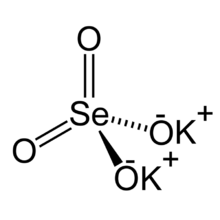Chemistry:Potassium selenate
From HandWiki

| |
| Identifiers | |
|---|---|
3D model (JSmol)
|
|
| EC Number |
|
PubChem CID
|
|
| RTECS number |
|
| UNII | |
| |
| |
| Properties | |
| K2SeO4 | |
| Molar mass | 221.2 g/mol[1] |
| Appearance | colorless crystals hygroscopic |
| Odor | odorless |
| Density | 3.07 g/cm3[2] |
| 1.07 g/ml (0 °C) 1.11 g/ml (20 °C) 1.22 g/ml (100 °C) | |
Refractive index (nD)
|
1.539 |
| Structure | |
| orthorhombic | |
| Hazards | |
| NFPA 704 (fire diamond) | |
| Related compounds | |
Other anions
|
Potassium sulfate |
Other cations
|
Sodium selenate |
Except where otherwise noted, data are given for materials in their standard state (at 25 °C [77 °F], 100 kPa). | |
| Infobox references | |
Potassium selenate, K2SeO4, is an odorless, white solid that forms as the potassium salt of selenic acid.
Preparation
Potassium selenate is produced by the reaction of selenium trioxide and potassium hydroxide.
- SeO
3 + 2 KOH → K
2SeO
4 + H
2O
Alternatively, it can be made by treating selenous acid with potassium hydroxide, followed by oxidation of the resulting potassium selenite with bromine water.[3]
- H
2SeO
3 + 2 KOH → K
2SeO
3 + 2 H
2O - K
2SeO
3 + 2 KOH + Br
2 → K
2SeO
4 + 2 KBr + H
2O
Uses
Potassium selenate can be used to produce selenium trioxide.[4] It can also use to treat selenium deficiency in livestock.[5]
References
- ↑ "Potassium Selenate K2SeO4 Molecular Weight". http://www.endmemo.com/chem/compound/k2seo4.php.
- ↑ "Potassium Selenate". https://www.americanelements.com/potassium-selenate-7790-59-2.
- ↑ Rosenfeld, Irene; Beath, Orville A. (2013). Selenium: Geobotany, Biochemistry, Toxicity, and Nutrition. Elsevier Science. p. 305. ISBN 978-1-4832-7590-1. https://books.google.com/books?id=dLLfBAAAQBAJ&pg=PA305.
- ↑ Sicius, Hermann (2015) (in de). Chalkogene : elemente der sechsten hauptgruppe.. Springer. p. 28. ISBN 978-3-658-10522-8. OCLC 919684689.
- ↑ Wolfgang Löscher, Angelika Richter, Heidrun Potschka (2014) (in de). Pharmakotherapie bei Haus- und Nutztieren. Stuttgart: Enke. ISBN 978-3-8304-1250-2. OCLC 891036290.
 |

